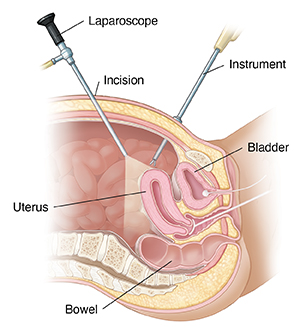Lap Hysterectomy
Laparoscopy & Hysteroscopy - Lap Hysterectomy
Book Appointment
For Appointment
When Will You Be Advised a Laparoscopic Hysterectomy?

What is Lap Hysterectomy?
A laparoscopic hysterectomy is a minimally invasive surgical procedure used to remove the uterus through small incisions in the abdomen. A thin, lighted instrument called a laparoscope, equipped with a camera, is inserted through one incision to allow the surgeon to see inside the abdomen, while other specialized tools are used through additional incisions to perform the surgery. This method is often preferred over traditional open surgery because it typically results in smaller scars, less pain, reduced blood loss, and a quicker recovery. Laparoscopic hysterectomy may be performed to treat conditions such as fibroids, endometriosis, abnormal uterine bleeding, uterine prolapse, or certain gynecologic cancers. Depending on the case, the entire uterus or just a portion may be removed, and sometimes the cervix, fallopian tubes, or ovaries are also taken out. While generally safe, the procedure does carry risks such as infection, bleeding, and potential injury to surrounding organs.
When Will You Be Advised a Laparoscopic Hysterectomy?
You may be advised to undergo a laparoscopic hysterectomy in the following situations:
- Uterine Fibroids – Noncancerous growths in the uterus causing pain, heavy bleeding, or pressure symptoms.
- Endometriosis – A condition where tissue similar to the uterine lining grows outside the uterus, leading to chronic pelvic pain or infertility.
- Abnormal Uterine Bleeding – Persistent, heavy, or irregular menstrual bleeding that doesn’t respond to other treatments.
- Uterine Prolapse or Cancer – When the uterus drops into the vaginal canal due to weakened pelvic muscles, or in certain early-stage gynecologic cancers.
Advantages of Laparoscopic Hysterectomy
A laparoscopic hysterectomy offers several advantages over traditional open surgery. Because it uses small incisions, it results in minimal scarring and less postoperative pain. Patients typically experience a faster recovery, allowing them to return to normal activities sooner. The procedure also usually involves a shorter hospital stay, often allowing discharge on the same day or the next. Additionally, there is a lower risk of infection and blood loss, and the use of a camera provides the surgeon with enhanced visualization for more precise surgical work. These benefits make laparoscopic hysterectomy a preferred option for many women when a hysterectomy is needed.
- Smaller Incisions – Leads to minimal scarring and a more cosmetic outcome.
- Faster Recovery – Most patients return to normal activities sooner compared to open surgery.
- Less Pain and Discomfort – Reduced need for pain medication after surgery.
- Shorter Hospital Stay – Often done as a same-day or one-night procedure.
- Lower Risk of Infection and Bleeding – Minimally invasive technique results in fewer complications.
- Improved Visualization – The camera provides a magnified view, helping the surgeon operate with precision.
